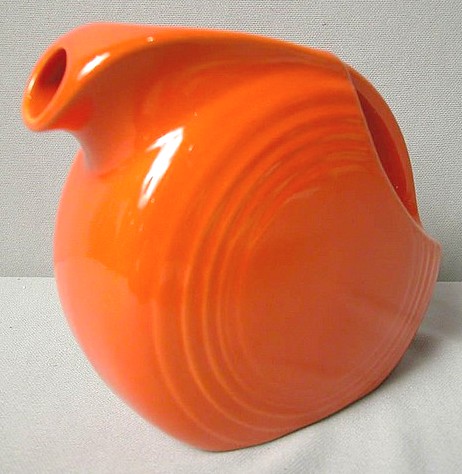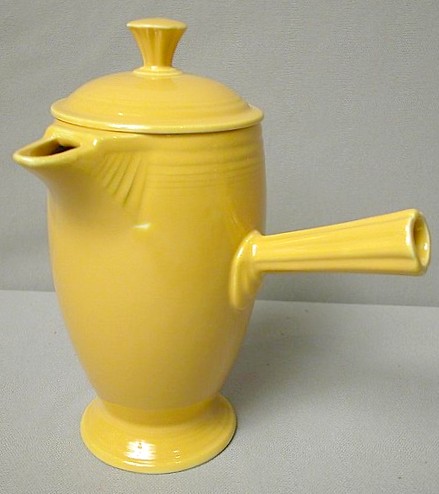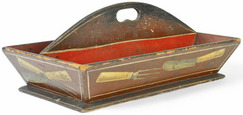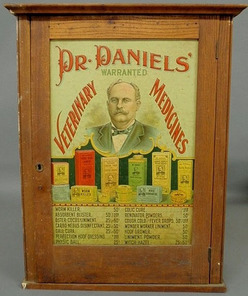
Fiesta disc juice pitcher in red glaze
Frugal Yet Fabulous Fiestaware!
In 1936, like every other pottery in America, the Homer Laughlin China Company was desperate for a new product that would generate sales during the difficult days of the depression. With help the talented Frederick Hurton Rhead (director of design from 1928-42), The Homer Laughlin Company found their answer in Fiestaware.
Bold Forms in Bright Colors
Immediately successful, Fiestaware dishes combined simple yet bold forms in bright colors. Originally produced in five colors: red (which was actually more of an orange) yellow, cobalt, light green, and ivory. Turquoise was added one year into production. The original palate was named “Old Mexico Colors.” These were stylish in California and other western states, but Fiesta made them popular in the rest of the country as well.
Art Deco Era Dishes
Fiestaware dishes were architectural in form and drew heavily from the visual vocabulary of Art Moderne and Art Deco style, including streamlined forms, concentric circles, and horizontal and vertical ribs and banding. These elements were combined with simple geometric forms, especially circles. Pieces were glazed in solid bright colors, and because the aesthetic appeal depended on form and color rather than expensive and time consuming hand decorating, the dishes were inexpensive to produce. The mass-produced crockery was sold at the Five & Dime, and was considered inexpensive, even during the Depression.

Fiesta yellow demitasse coffee pot
Fiestaware to Mix and Match
The six colors worked well together, and a new table fashion was born- mixing and matching; each place setting could be a different color, or a home maker might mix the colors within a place setting. The dishes could be one color and the accessories another. A pitcher could be cobalt and the tumblers red, or each tumbler could be a different color. Consumers loved the infinite possibilities.
Fiestaware was so popular that it was produced until 1973. In 1959, new colors- forest green, rose, chartreuse, medium grey, and medium green were added. Production ended temporarily in ’73, but styles cycled back, as styles are apt to do. In 1986, and Homer Laughlin reintroduced Fiestaware, and it is still in production today.
Collectible Fiestaware
Fiesta collectors look for early examples (pre-1969), especially of accessories and serving pieces. Since a set of dishes might have 8 dinner plates but only 2 serving bowls, the bowls are harder to find, and therefore more valuable. Collectors love the vases, salt and pepper shakers, pitchers, tea pots, coffee pots, candle holders, gravy boats and mixing bowls.
Pieces such as covered butters, tea & coffee pots, and casseroles with intact covers are desirable because the lids frequently were broken, are the tumblers that rarely survived the tentative grasp of clumsy children. As is the case with all collectible pottery, the most valuable pieces will be free of chips, cracks and crazing, although some allowances are made for hard to find pieces in rare colors.
-By p4A Contributing Editor Susan Cramer.
Reference & Further Recommended Reading:
To search the Prices4Antiques antiques reference database for valuation information on hundreds of thousands of antiques and fine art visit our homepage www.prices4antiques.com
![Sailor Craftwork; Pie Crimper, Whalebone & Ivory, Pillared Handle, Double Wheel, Fork, 7 inch. A scrimshaw whalebone crimper [pie crimper or jagging wheel] with whale ivory double wheels](http://www.prices4antiques.com/item_images/medium/68/55/63-01.jpg) A jagging wheel, also sometimes known as a pie crimp or a pie crimper, is a fluted or crenellated wheel used to trim and/or to seal the edges of pastry crusts. They were also some of the most common items produced from ivory by whalers who practiced the arts of ivory carving and scrimshaw in their spare time on long sea voyages. (Iron and wooden jagging wheels also occasionally appear on the market, but the vast majority of them are ivory or bone.) More elaborate examples have pierced carvings throughout the handle and the wheel and it is not at all uncommon for the design to incorporate a fork either on the handle or diverging from the handle above the wheel for pricking vents in pastry.
A jagging wheel, also sometimes known as a pie crimp or a pie crimper, is a fluted or crenellated wheel used to trim and/or to seal the edges of pastry crusts. They were also some of the most common items produced from ivory by whalers who practiced the arts of ivory carving and scrimshaw in their spare time on long sea voyages. (Iron and wooden jagging wheels also occasionally appear on the market, but the vast majority of them are ivory or bone.) More elaborate examples have pierced carvings throughout the handle and the wheel and it is not at all uncommon for the design to incorporate a fork either on the handle or diverging from the handle above the wheel for pricking vents in pastry.

![Boot Scraper; Cat with Long Tail, Cast Iron, 16 inch. A cast iron boot scraper, unattributed, in the form of a cat with [long tail and] traces of black paint.](http://www.prices4antiques.com/item_images/medium/55/14/63-01.jpg)





